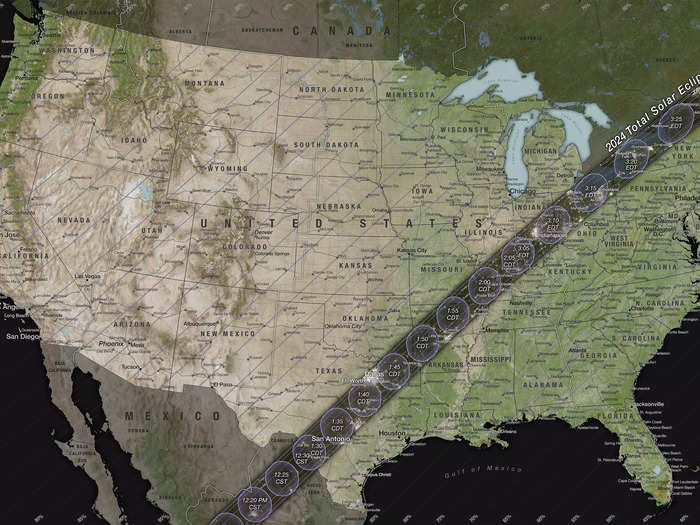
A total solar eclipse at 100% totality.John Finney photography / Getty Images
A total solar eclipse is crossing the US on April 8, 2024, giving more than 30 million people the rare opportunity to watch the moon obscure the sun and darken the skies.
That's just the people who live in the eclipse's path. Countless others can see it just by driving an hour or two, or taking a short flight.
To see totality — the moment when the moon fully blocks the sun — you need to be in exactly the right place at exactly the right time.
Luckily, NASA made a map to pinpoint just where you should be, and when you should be there.

NASA made this detailed map showing the path of totality for the April 8 total solar eclipse.

White lines on the NASA map, running down the path of totality, indicate how long the eclipse will last along those lines.

The outermost lines along the path show where the eclipse will last a minute or two. On the innermost lines, it will last four minutes.
Purple and yellow lines cutting across the map also show where you can see a partial eclipse outside the paths of the moon's full shadow.

Texas hits a home run with this eclipse, which will begin near San Antonio, Austin, and Dallas.

Then the eclipse will cast its shadow across the Ozarks in Arkansas and southeastern Missouri.

People in the Midwest can flock to southern Illinois, Indianapolis, or Cleveland to get into the path of totality.

Much of the northeast can get its eclipse fix by driving to upstate New York. Niagara Falls, Buffalo, and Syracuse are all in the path of totality.

Everyone's last chance to see a total solar eclipse in the contiguous US for another 20 years will be late afternoon in northern Vermont, New Hampshire, and Maine.

No matter where you are, don't forget eclipse glasses to protect your eyes from permanent damage.
Eclipse glasses are thousands of times darker than regular sunglasses. They should comply with the ISO 12312-2 international standard.
Beware of counterfeits! Look for the real thing through the American Astronomical Society.

Don't look at the sun through a camera, telescope, or binoculars either. They will concentrate the sun's rays and injure your eyes, unless you have secured a special solar filter.

Only at the moment of totality can you safely remove your eclipse glasses. Happy viewing!
 A centenarian who starts her day with gentle exercise and loves walks shares 5 longevity tips, including staying single
A centenarian who starts her day with gentle exercise and loves walks shares 5 longevity tips, including staying single  A couple accidentally shipped their cat in an Amazon return package. It arrived safely 6 days later, hundreds of miles away.
A couple accidentally shipped their cat in an Amazon return package. It arrived safely 6 days later, hundreds of miles away. FSSAI in process of collecting pan-India samples of Nestle's Cerelac baby cereals: CEO
FSSAI in process of collecting pan-India samples of Nestle's Cerelac baby cereals: CEO Having an regional accent can be bad for your interviews, especially an Indian one: study
Having an regional accent can be bad for your interviews, especially an Indian one: study
 Dirty laundry? Major clothing companies like Zara and H&M under scrutiny for allegedly fuelling deforestation in Brazil
Dirty laundry? Major clothing companies like Zara and H&M under scrutiny for allegedly fuelling deforestation in Brazil
 5 Best places to visit near Darjeeling
5 Best places to visit near Darjeeling

Copyright © 2024. Times Internet Limited. All rights reserved.For reprint rights. Times Syndication Service.